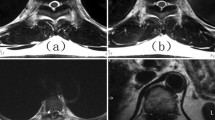Summary
Sixteen cases of thoracic radiculomyelopathy due to ossification of the ligamentum flavum (OLF) were analyzed. The patients ranged in age from 39 to 78 years (average 57 years). There were 13 men and 3 women. A significant predilection of OLF for the lower thoracic spine (T9/10, T10/11, T11/12) was noticed. Plain X-ray of the thoracic spine and multidirectional tomography could give important information about the site of ossification. Computed tomography with the intrathecal injection of the water-soluble contrast material clearly demonstrated the ossification and the degree of compression of the spinal cord. The disadvantages of using computed tomography for diagnosing OLF included the necessity for the scan level to be previously decided by other methods because computed tomography of the entire spine was impractical. Magnetic resonance imaging was performed in 14 patients and gave important information about OLF and the compression of the spinal cord. The combination of MRI and computed tomography seems the most useful for the precise diagnosis of OLF.
Similar content being viewed by others
References
Barnett GH, Hardy RW Jr, Bay JW, Sypert GW (1987) Thoracic spinal canal stenosis. J Neurosurg 66:338–344
Nurick S (1972) The pathogenesis of the spinal cord disorder associated with cervical spondylosis. Brain 95:87–100
Jaspan T, Holland IM, Punt JA (1987) Thoracic spinal stenosis. Neuroradiology 29:217
Yamamoto I, Matsumae M, Ikeda A, Shibuya N, Sato O, Nakamura K (1988) Thoracic spinal stenosis: experience with seven cases. J Neurosurg 68:37–40
Govoni AF (1971) Developmental stenosis of a thoracic vertebra resulting in narrowing of the spinal canal. AJR 112:401–404
Yonenobu K, Ebara S, Fujiwara K, Yamashita K, Ono K, Yamamoto T, Harada N, Ogino H, Ojima S (1987) Thoracic myelopathy secondary to ossification of the spinal ligament. J Neurosurg 66:511–518
Omojola MF, Cardoso ER, Fox AJ, Drake CG, Durward QJ. (1982) Thoracic myelopathy secondary to ossified ligamentum flavum. J Neurosurg 56:448–450
Smith DF, Godersky JC (1987) Thoracic spondylosis: An unusual cause of myelopathy. Neurosurgery 20:589–593
Marzluff JM, Hungerford GD, Kempe LG, Rawe SE, Trevor R, Perot PL Jr (1979) Thoracic myelopathy caused by osteophytes of the articular processes. Thoracic spondylosis. J Neurosurg 50: 779–783
Friedman E (1962) Narrowing of spinal canal due to thickened lamina: cause of lowback pain and sciatica. Clin Orthop 21:190–197
Miyasaka K, Kaneda K, Ito T, Takei H, Sugimoto S, Tsuru M (1982) Ossification of spinal ligaments causing thoracic radiculomyelopathy. Radiology 143:463–468
Author information
Authors and Affiliations
Rights and permissions
About this article
Cite this article
Hanakita, J., Suwa, H., Ohta, F. et al. Neuroradiological examination of thoracic radiculo-myelopathy due to ossification of the ligamentum flavum. Neuroradiology 32, 38–42 (1990). https://doi.org/10.1007/BF00593939
Received:
Issue Date:
DOI: https://doi.org/10.1007/BF00593939



